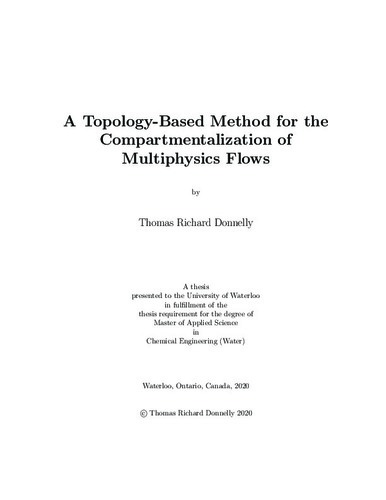| dc.contributor.author | Donnelly, Thomas Richard | |
| dc.date.accessioned | 2020-09-28 19:19:31 (GMT) | |
| dc.date.available | 2020-09-28 19:19:31 (GMT) | |
| dc.date.issued | 2020-09-28 | |
| dc.date.submitted | 2020-09-22 | |
| dc.identifier.uri | http://hdl.handle.net/10012/16393 | |
| dc.description.abstract | Continuum simulations of multiphysics processes are costly due to the coupling of transport phenomena.
Compartment modelling decouples hydrodynamics from other transport phenomena, offering a low-cost simulation alternative for applications such as design screening.
While different methods will produce compartment models with different accuracy levels, no rigorous compartmentalization approaches currently exist.
In this work, a compartmentalization algorithm is proposed that identifies distinct flow modes from an analysis of the topology of a fluid velocity field.
This topological analysis is based on an analogy between modes of fluid flow and deformation modes that have been identified for the molecular alignment of liquid crystals.
A velocity alignment vector is defined and used to compute the deformation modes splay, twist, and bend for a velocity field.
This topologically-informed compartmentalization algorithm is developed through its application to a test case of steady single-phase laminar flow through a cylindrical vessel with a step increase in cross-sectional area.
This case is observed to exhibit unidirectional, recirculatory, and diverging flow based on a continuum simulation.
Local alignment deformation, defined as the sum of splay, twist, and bend for a velocity field, is computed and thresholded to segment the domain into compartments dominated by each of the distinct flow modes.
These compartments are incorporated into a compartment model, which is validated against the continuum simulation through a comparison of their residence time distributions (RTDs).
The compartment model RTD is shown to deviate from the continuum simulation in terms of having lower mean residence time, higher variance, and higher skewness.
The deviation between the compartment model and continuum simulation is attributed to the approximation of unidirectional compartments as well-mixed.
The compartment model is modified to approximate each unidirectional compartment as a series of ideal continuous stirred-tank reactors (CSTRs), which improves the variance and skewness of the RTD but does not increase the mean residence time.
As a final modification to the compartment model considered, an adjustment to the thresholding used for the compartment model is shown to have an insignificant effect on the RTD.
While additional work is required to improve the accuracy of the compartment modelling approach proposed, compartment models based on velocity topology offer a promising approach for multiphysics simulation. | en |
| dc.language.iso | en | en |
| dc.publisher | University of Waterloo | en |
| dc.title | A Topology-Based Method for the Compartmentalization of Multiphysics Flows | en |
| dc.type | Master Thesis | en |
| dc.pending | false | |
| uws-etd.degree.department | Chemical Engineering | en |
| uws-etd.degree.discipline | Chemical Engineering (Water) | en |
| uws-etd.degree.grantor | University of Waterloo | en |
| uws-etd.degree | Master of Applied Science | en |
| uws.contributor.advisor | Abukhdeir, Nasser Mohieddin | |
| uws.contributor.advisor | Pritzker, Mark | |
| uws.contributor.affiliation1 | Faculty of Engineering | en |
| uws.published.city | Waterloo | en |
| uws.published.country | Canada | en |
| uws.published.province | Ontario | en |
| uws.typeOfResource | Text | en |
| uws.peerReviewStatus | Unreviewed | en |
| uws.scholarLevel | Graduate | en |

